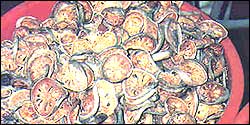 Capsule
Bilv Giri
Capsule
Bilv Giri
Latin name: Aegle Marmelos
Family: Rutaceae
Common name: Bael, Sirphal
English name: Wood apple, Bengal
Quince
Habitat: It is found in sub-Himalayan
tract, central and southern India.
Macroscopic identification: The bael
fruit tree is slow growing, of medium size,
up to 12-15 m tall. A clear, gummy sap, resembling
gum, exudes from wounded branches and hangs
down in long strands, becoming gradually solid.
It is sweet at first taste and then irritating
to the throat. Mature leaves emit a disagreeable
odor when bruised. Flowers are yellow in color
fragrant and in clusters of 4 to 7 along the
young branchlets, The fruit, round, oval, or
oblong, 2 to 8 in (5-20 cm) in diameter, may
have a thin, hard, woody shell or a more or
less soft rind, gray-green until the fruit is
fully ripe, when it turns yellowish.
Parts used: Fruit, root-bark, leaves,
rind, flowers
Pharmacological action: anti bilious,
anti parasitical, antipyretic, aphrodisiac,
aromatic, alterative, astringent; digestive
stimulant, febrifuge, haemostatic, laxative,
nutritive, stomachic, stimulant, tonic.
Actions and uses in ayurveda: pravahika,
agnimandya, grahniroga
Indications: Ripe fruit is sweet, aromatic,
cooling, alterative and nutritive. Fresh fruit
has laxative properties. Unripe fruit is astringent,
digestive, stomachic, and constipative. Pulp
is stimulant, antipyretic and antiscorbutic.
Fresh juice is bitter and pungent.
Photochemical: Chemical studies have
revealed the following properties in the
roots: psoralen, xanthotoxin, O-methylscopoletin,
scopoletin, tembamide, and skimmin; also decursinol,
haplopine and aegelinol.
The bark contains tannin and the cournarin,
aegelinol; also the furocourmarin, marmesin;
umbelliferone, a hydroxy coumarin; and the alkaloids,
fagarine and skimmianine.
Bitter, light-yellow oil extracted from the
seeds is given in 1.5 g doses as a purgative.
It contains 15.6% palmitic acid, 8.3% stearic
acid, 28.7% linoleic and 7.6% linolenic acid.
The seed residue contains 70% protein
The pulp also contains a balsam-like
substance, and 2 furocoumarins-psoralen and
marmelosin (C13H12O3),
highest in the pulp of the large, cultivated
forms.
The essential oil of the leaves contains
d-limonene, 56% a-d-phellandrene, cineol, citronellal,
citral; 17% p-cyrnene, 5% cumin aldehyde. The
leaves contain the alkaloids O-(3,3-dimethylallyl)-halfordinol,
N-2-ethoxy-2-(4-methoxyphenyl) ethylcinnamide,
N-2-methoxy-2-[4-(3',3'-dimethyalloxy) phenyll]ethylcinnamide,
and N-2-methoxy-2-(4-methoxyphenyl)-ethylcinnamamide.
Properties and action:
Rasa: katu, tikta, kasaya
Guna: laghu, ruksha
Virya: usna
Vipaka: katu
Karma: dipana, pachana, grahi, vatkapha-hara,
balya.
Preparations: Decoction, Leaf-juice,
powder
Therapeutic classification index:
- Cardiovascular system: Decoctions
of the root are taken to relieve palpitations
of the heart. The leaves of Aegle Marmelos
contained digoxin-like active principles which
were found to be cardio active substances
as indicated and confirmed by the pharmacological
studies
- Respiratory system: The leaf decoction
is said to alleviate asthma
- Digestive system: Decoctions of
the root are taken to relieve, indigestion,
and bowel inflammations; also to overcome
vomiting. The unripe bael is most prized as
a means of halting diarrhea and dysentery,
which are prevalent in India in the summer
months. The fresh ripe pulp of the higher
quality cultivars, and the "sherbet" made
from it, are taken for their mild laxative,
tonic and digestive effects. A decoction of
the unripe fruit, with fennel and ginger,
is prescribed in cases of hemorrhoids. Claims
have been made that it relieves chronic flatulent
colic in patients suffering from chronic gastro-intestinal
catarrh. It is helpful in sprue also. It also
gives good results in amoebic dysentery.
- Skin: The bark decoction is administered
in cases of malaria. It has been surmised
that the psoralen in the pulp increases tolerance
of sunlight and aids in the maintaining of
normal skin color. It is employed in the treatment
of leucoderma.
- Eye: A decoction of the flowers
is used as eye lotion
- Nutrition and metabolism: it is a
good source of vitamins
- Immunity system: The fruit, roots
and leaves have antibiotic activity. The root,
leaves and bark are used in treating snakebite
- Reproductive system: it is used
in inflammation of uterus, leucorrhoea and
puerperal diseases.
Food Value Per 100 g of Edible Portion of
Bilv fruit
|
Water
|
54.96-61.5 g
|
|
Protein
|
1.8-2.62 g
|
|
Fat
|
0.2-0.39 g
|
|
Carbohydrates
|
28.11-31.8 g
|
|
Ash
|
1.04-1.7 g
|
|
Carotene
|
55 mg
|
|
Thiamine
|
0.13 mg
|
|
Riboflavin
|
1.19 mg
|
|
Niacin
|
1.1 mg
|
|
Ascorbic Acid
|
8-60 mg
|
|
Tartaric Acid
|
2.11 mg
|
Dose: powder-3-6g
Juice extract-10-20ml
Capsule Bilv Giri contains
pure and concentrated Bilv Giri
Dosage:
one capsule twice a day.
Package 60 capsules
References:
- Prof P.V Sharma, Dravya Guna Vigyana, Vol
II, pg 455-457
- Dr.KM Nadkarni, The Indian Materia Medica,
Vol.I, pg 45-49
- The Ayurvedic Pharmacopoeia Of India, Part
I, Vol.I, pg 27
- Supplement to Glossary Of Medicinal Plants
by R.N Chopra, S.LNayar, I.C Chopra pg 3
- Glossary Of Medicinal Plants by R.N Chopra,
S.LNayar, I.C Chopra pg 8